
- |<
- <
- 1
- >
- >|
-
Yoshiyuki Kubo, Shin-ichi Akanuma, Ken-ichi Hosoya2016 年 39 巻 12 号 p. 1903-1911
発行日: 2016/12/01
公開日: 2016/12/01
ジャーナル フリー HTMLCumulative studies showed that taurine (2-aminoethanesulfonic acid) contributes to a variety of physiological events. Transport study suggested the cellular taurine transport in an Na+- and Cl−-dependent manner, and the several members of SLC6A family have been shown as taurine transporter. At the inner blood–retinal barrier (BRB), taurine transporter (TauT/SLC6A) is involved in the transport of taurine to the retina from the circulating blood. The involvement of TauT is also suggested in γ-aminobutyric acid (GABA) transport at the inner BRB, and its role is assumed in the elimination of GABA from the retinal interstitial fluid. In the retina, taurine is thought to be a major organic osmolyte, and its influx and efflux through TauT and volume-sensitive organic osmolyte and anion channel (VSOAC) in Müller cells regulate the osmolarity in the retinal microenvironment to maintain a healthy retina. In the liver, hepatocytes take up taurine via GABA transporter 2 (GAT2/SLC6A13, the orthologue of mouse GAT3) expressed at the sinusoidal membrane of periportal hepatocytes, contributing to the metabolism of bile acid. Site-directed mutagenesis study suggests amino acid residues that are crucial in the recognition of substrates by GATs and TauT. The evidence suggests the physiological impact of taurine transporters in tissues.
 Graphical Abstract Fullsize Image抄録全体を表示PDF形式でダウンロード (2620K) HTML形式で全画面表示
Graphical Abstract Fullsize Image抄録全体を表示PDF形式でダウンロード (2620K) HTML形式で全画面表示
-
Noboru Uchide, Kyoko Obatake, Rie Yamada, Hidetaka Sadanari, Keiko Mat ...2016 年 39 巻 12 号 p. 1912-1921
発行日: 2016/12/01
公開日: 2016/12/01
ジャーナル フリー HTMLIn order to understand a possible etiology of adverse pregnancy outcomes associated with intrauterine influenza virus infection, we examined the effect of influenza virus infection on gene expression of matrix metalloproteinases (MMPs) in cultured amnion epithelial, amnion mesenchymal and chorion trophoblast cells prepared from human fetal membrane tissues by gelatin zymography, Western blotting and reverse transcriptase-PCR. The cells were infected with influenza A (H1N1) virus. The levels of pro-MMP-9 activity in culture supernatants of three types of cells were increased during the period of 24–48 h after the virus infection as compared to those of mock infection. Chorion trophoblast cells spontaneously released a much greater level of pro-MMP-2 activity than amnion epithelial and amnion mesenchymal cells. The cleavage of pro-MMP-2 into an active intermediate form was enhanced in chorion trophoblast cells by the virus infection. The activity levels of MMP-2 and MMP-9 in culture supernatants were consistent with their protein levels. The virus infection induced the mRNA expression of MMP-9, but not MMP-2, in three types of cells. These results suggest that influenza virus infection induces the gene expression of MMP-9 and the cleavage of pro-MMP-2 into an active intermediate form in human fetal membrane cells, resulting in weakening of the membranes through extracellular matrix degradation. Therefore, it is possible that the regulation of MMPs gene expression in fetal membrane cells by influenza virus infection is implicated in a part of the etiology of adverse pregnancy outcomes associated with intrauterine infection with the virus.
 Graphical Abstract Fullsize Image抄録全体を表示PDF形式でダウンロード (10314K) HTML形式で全画面表示
Graphical Abstract Fullsize Image抄録全体を表示PDF形式でダウンロード (10314K) HTML形式で全画面表示 -
Sheu-Ran Choi, Soon-Gu Kwon, Hoon-Seong Choi, Ho-Jae Han, Alvin James ...2016 年 39 巻 12 号 p. 1922-1931
発行日: 2016/12/01
公開日: 2016/12/01
[早期公開] 公開日: 2016/09/07ジャーナル フリー HTML
電子付録We recently demonstrated that activation of spinal sigma-1 receptors (Sig-1Rs) induces pain hypersensitivity via the activation of neuronal nitric oxide synthase (nNOS) and nicotinamide adenine dinucleotide phosphate (NADPH) oxidase 2 (Nox2). However, the potential direct interaction between nNOS-derived nitric oxide (NO) and Nox2-derived reactive oxygen species (ROS) is poorly understood, particularly with respect to the potentiation of N-methyl-D-aspartate (NMDA) receptor activity in the spinal cord associated with the development of central sensitization. Thus, the main purpose of this study was to investigate whether Sig-1R-induced and nNOS-derived NO modulates spinal Nox2 activation leading to an increase in ROS production and ultimately to the potentiation of NMDA receptor activity and pain hypersensitivity. Intrathecal pretreatment with the nNOS inhibitor, 7-nitroindazole or with the Nox inhibitor, apocynin significantly inhibited the mechanical and thermal hypersensitivity induced by intrathecal administration of the Sig-1R agonist, 2-(4-morpholinethyl) 1-phenylcyclohexanecarboxylate hydrochloride (PRE084). Conversely, pretreatment with 5,10,15,20-tetrakis-(4-sulphonatophenyl)-porphyrinato iron(III) (FeTPPS; a scavenger of peroxynitrite, a toxic reaction product of NO and superoxide) had no effect on the PRE084-induced pain hypersensitivity. Pretreatment with 7-nitroindazole significantly reduced the PRE084-induced increase in Nox2 activity and concomitant ROS production in the lumbar spinal cord dorsal horn, whereas apocynin did not alter the PRE084-induced changes in nNOS phosphorylation. On the other hand pretreatment with apocynin suppressed the PRE084-induced increase in the protein kinase C (PKC)-dependent phosphorylation of NMDA receptor GluN1 subunit (pGluN1) at Ser896 site in the dorsal horn. These findings demonstrate that spinal Sig-1R-induced pain hypersensitivity is mediated by nNOS activation, which leads to an increase in Nox2 activity ultimately resulting in a ROS-induced increase in PKC-dependent pGluN1 expression.
 Graphical Abstract Fullsize Image抄録全体を表示PDF形式でダウンロード (2591K) HTML形式で全画面表示
Graphical Abstract Fullsize Image抄録全体を表示PDF形式でダウンロード (2591K) HTML形式で全画面表示 -
Sachiko Juman, Yasuo Nara, Naomi Yasui, Hiroko Negishi, Hiroto Okuda, ...2016 年 39 巻 12 号 p. 1932-1938
発行日: 2016/12/01
公開日: 2016/12/01
ジャーナル フリー HTMLStroke-prone spontaneously hypertensive rats (SHRSP/Izm; SHRSP) develop severe hypertension and die of cerebral stroke. However, the genetic mechanisms underlying their stroke susceptibility have not been clarified yet. In this study, we used astrocytes from the newborn brain cortex of spontaneously hypertensive rats (SHR/Izm; SHR) and SHRSP to find the difference of genetic characteristics. Astrocytes are known to have functions of vasodilation and nutrient uptake for neurons in the brain. The continuous generation of hydrogen peroxide (H2O2) dose-dependently causes cell death in astrocytes, and SHRSP was more vulnerable than SHR. We found that the total thiols decreased in SHRSP astrocytes but the total glutathione (GSH) did not change. Hydrogen sulfide (H2S), which is known to protect cells through anti-oxidant and vasodilatory effects, is produced by cystathionine β-synthase (CBS) in astrocytes. We found that H2S production was significantly decreased in SHRSP as compared to SHR. This was caused by the decreasing expression of mRNA, protein and enzyme activity of CBS in astrocytes. We also found that astrocyte cell death from oxidative stress could be prevented by GYY4137 H2S donor. H2S is also known to cause protein S-sulfhydration to modify enzyme activity. Sulfane sulfur in astrocytes was significantly lower in SHRSP and decreased by CBS inhibitor. We showed that astrocytes in SHRSP vulnerable to oxidative stress may be caused by reduction of H2S through lower expression and activity of CBS.
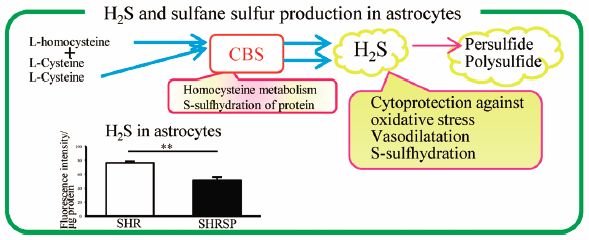 Graphical Abstract Fullsize Image抄録全体を表示PDF形式でダウンロード (927K) HTML形式で全画面表示
Graphical Abstract Fullsize Image抄録全体を表示PDF形式でダウンロード (927K) HTML形式で全画面表示 -
Isao Tsuboi, Tomonori Harada, Yoko Hirabayashi, Jun Kanno, Shin Aizawa2016 年 39 巻 12 号 p. 1939-1947
発行日: 2016/12/01
公開日: 2016/12/01
ジャーナル フリー HTML
電子付録Chronic lipopolysaccharide (LPS) exposure to mice reduces the lymphoid compartment and skews the hematopoietic cell compartment toward myeloid-cells, which is considered to be a direct effect of LPS on hematopoietic stem cells. However, the effect of chronic LPS exposure on stromal-cells, which compose the hematopoietic microenvironment, has not been elucidated. Here, we investigated early- and late-phase effects of repeated LPS exposure on stromal-cells. During the early phase, when mice were treated with 5 or 25 µg LPS three times at weekly intervals, the numbers of myeloid-progenitor (colony forming unit-granulocyte macrophage (CFU-GM)) cells and B lymphoid-progenitor (CFU-preB) cells in the bone-marrow (BM) rapidly decreased after each treatment. The number of CFU-GM cells recovered from the initial decrease and then increased to levels higher than pretreatment levels, whereas the number of CFU-preB cells remained lower than pretreatment levels. In the BM, expression of genes for positive-regulators of myelopoiesis including granulocyte colony-stimulating factor (G-CSF), granulocyte macrophage colony-stimulating factor (GM-CSF), and interleukin (IL)-6 and negative-regulators of B lymphopoiesis including tumor necrosis factor (TNF)-α was up-regulated, whereas expression of positive-regulators of B lymphopoiesis including stromal cell-derived factor (SDF)-1, IL-7, and stem cell factor (SCF) was down-regulated. During the late phase, the number of CFU-preB cells remained lower than pretreatment levels 70 d after the first treatments with 5 and 25 µg LPS, whereas the number of CFU-GM cells returned to pretreatment levels. IL-7 gene expression in the BM remained down-regulated, whereas gene-expression levels of SDF-1 and SCF were restored. Thus, chronic LPS exposure may impair stromal-cell function, resulting in prolonged suppression of B lymphopoiesis, which may appear to be senescence similar to the hematological phenotype.
 Graphical Abstract Fullsize Image抄録全体を表示PDF形式でダウンロード (1402K) HTML形式で全画面表示
Graphical Abstract Fullsize Image抄録全体を表示PDF形式でダウンロード (1402K) HTML形式で全画面表示 -
Duopeng An, Xiang Wang, Jun Li, Shanshan Jiang, XiaoJuan Ma, Hui Zhang ...2016 年 39 巻 12 号 p. 1948-1954
発行日: 2016/12/01
公開日: 2016/12/01
[早期公開] 公開日: 2016/09/08ジャーナル フリー HTML
電子付録The effect of fungichromin (FC) on the formation of Candida albicans biofilm was assessed using 2,3-bis(2-methoxy-4-nitro-5-sulfo-phenyl)-2H-tetrazolium-5-carboxanilide (XTT) reduction method, scanning electron microscopy (SEM) and confocal laser scanning microscopy (CLSM). Results showed that FC revealed an inhibitory effect on the formation of C. albicans biofilm in a dose-dependent manner with a minimum inhibitory concentration (MIC) of 10 µg/mL. Over 80% of biofilm formation was inhibited by FC at the concentration of 40 µg/mL when compared with the control. Similarly, real-time PCR showed that the expression of the genes such as ALS1, ALS3, HWP1, EFG1, HYR1, CPH1 and BCR1 appeared to be remarkably affected by FC at the concentration of 20 µg/mL during the biofilm formation. In addition, FC could also induce the apoptosis of C. albicans cells in a dose-dependent manner. Therefore, FC displayed potent activity against the formation of C. albicans biofilm in vitro and played an important role in reducing the incidence of device-associated infections.
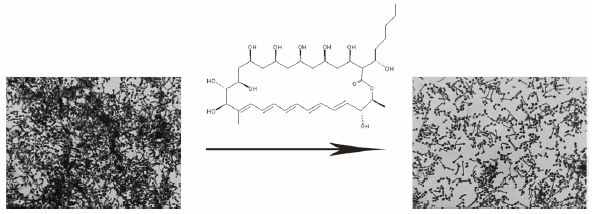 Graphical Abstract Fullsize Image抄録全体を表示PDF形式でダウンロード (4136K) HTML形式で全画面表示
Graphical Abstract Fullsize Image抄録全体を表示PDF形式でダウンロード (4136K) HTML形式で全画面表示 -
Akiyo Hirose, Wataru Ochiai, Yuka Yamamoto, Masashi Fukaya, Hiroshi Iw ...2016 年 39 巻 12 号 p. 1955-1960
発行日: 2016/12/01
公開日: 2016/12/01
ジャーナル フリー HTMLCytochrome P450 enzymes (CYPs) are involved in the metabolism of various substances in the liver and small intestine and show markedly higher expression levels in the liver compared to other organs. The liver exhibits a remarkable capacity to regenerate. After excision of 70% of the liver, the organ can regenerate to its original size in approximately 1 week. Unlike the normal liver, in the injured liver, hepatic stem cells known as oval cells are considered to play an important role in regeneration. However, the role of CYPs in liver regeneration remains unclear. In the present study, we investigated the role of CYPs in the regeneration of injured liver. Liver injury was induced by 4-week repeated doses of 3,5-diethoxycarbonyl-1,4-dihydrocollidine (DDC) in the diet. Next, both DDC-fed mice and control diet (containing no DDC)-fed mice were subjected to 70% hepatectomy, and the hepatic gene expression patterns measured during regeneration were analyzed. Mice with DDC-induced liver injury expressed the oval cell markers cytokeratin 19 (CK19) and epithelial cell adhesion molecule (EpCAM), and partial hepatectomy increased the expression levels of CYP2R1 and CYP26A1 as well as the hepatoblast marker alpha-fetoprotein (AFP) in these mice. The results of this study suggest that CYP2R1 and CYP26A1 are important in the differentiation of oval cells into hepatoblast-like cells in the injured liver.
 Graphical Abstract Fullsize Image抄録全体を表示PDF形式でダウンロード (932K) HTML形式で全画面表示
Graphical Abstract Fullsize Image抄録全体を表示PDF形式でダウンロード (932K) HTML形式で全画面表示 -
Xiaojie Huang, Genyun Tang, Yumei Liao, Xiaoji Zhuang, Xiao Dong, Hui ...2016 年 39 巻 12 号 p. 1961-1967
発行日: 2016/12/01
公開日: 2016/12/01
[早期公開] 公開日: 2016/09/08ジャーナル フリー HTMLAmyloid-β (Aβ) is one of the major causative agents of Alzheimer’s disease (AD), the most common neurodegenerative disorder characterized by progressive cognitive impairment. While effective drugs for AD are currently limited, identifying anti-Aβ compounds from natural products has been shown as a promising strategy which may lead to breakthroughs for new drug candidate discovery. We have previously reported that 7-(4-hydroxyphenyl)-1-phenyl-4E-hepten-3-one (AO-1), a diarylheptanoid extracted from the plant Alpinia officinarum, has strong effects on neuronal differentiation and neurite outgrowth in vitro and in vivo. The present study further uncovers that AO-1 exerts neuroprotective effects against the neurotoxicity caused by Aβ. Under the damage of Aβ oligomers, the major pathological forms of Aβ, dendrites of neurons become atrophic and simplified, but such impairments were substantially alleviated by AO-1 treatment. Moreover, AO-1 reduced apoptotic levels and oxidative stress triggered by Aβ. Further analysis showed that the anti-caspase and dendrite protective effects of AO-1 were dependent on activation of phosphatidylinositol 3-kinase (PI3K)-mammalian target of rapamycin (mTOR) pathways. These findings collectively identify AO-1 as a beneficial compound to ameliorate the deleterious effects of Aβ on dendrite integrity and cell survival, and may provide new insights on drug discovery of AD.
 Graphical Abstract Fullsize Image抄録全体を表示PDF形式でダウンロード (1613K) HTML形式で全画面表示
Graphical Abstract Fullsize Image抄録全体を表示PDF形式でダウンロード (1613K) HTML形式で全画面表示 -
Ryota Tanaka, Yosuke Suzuki, Yukie Takumi, Motoshi Iwao, Yuhki Sato, K ...2016 年 39 巻 12 号 p. 1968-1973
発行日: 2016/12/01
公開日: 2016/12/01
ジャーナル フリー HTMLLinezolid is an oxazolidinone antibiotic against Gram-positive bacteria. Although thrombocytopenia is a major adverse effect of linezolid, hyponatremia also often develops after linezolid administration. This study examined the frequency of hyponatremia that developed during linezolid treatment and identified its risk factors. In this retrospective, single-center, observational cohort study, 61 hospitalized patients treated with linezolid between January 2013 and January 2015 were analyzed. Hyponatremia was defined as a sodium level of ≤134 mEq/L for the duration of linezolid treatment. Its risk factors were identified via a logistic regression analysis. Hyponatremia occurred in 11 (18.0%) patients, and it was severe in a case (a sodium level of ≤128 mEq/L). Univariate and multiple logistic regression analyses identified the plasma C-reactive protein (CRP) level before the initial administration of linezolid and the concomitant use of a potassium-sparing diuretic as the independent variables associated with the development of hyponatremia. The odds ratios were 1.081 (95% confidence interval [CI]; 1.008–1.158) (p=0.028) and 11.017 (95% CI; 1.869–64.939) (p=0.008), respectively. Before linezolid treatment, the CRP levels of the hyponatremia group were significantly higher than those of the no-hyponatremia group (p<0.001). The frequency of hyponatremia development was significantly higher in the patients who received both the potassium-sparing diuretic and linezolid (p=0.016). These results suggest that the plasma sodium levels of patients with severe inflammation who are treated with linezolid and those of linezolid-treated patients co-administered a potassium-sparing diuretic should be continuously monitored.
 Graphical Abstract Fullsize Image抄録全体を表示PDF形式でダウンロード (325K) HTML形式で全画面表示
Graphical Abstract Fullsize Image抄録全体を表示PDF形式でダウンロード (325K) HTML形式で全画面表示 -
Ibrahim Gayadh Algayadh, Venkateshwararao Dronamraju, Paul William Syl ...2016 年 39 巻 12 号 p. 1974-1982
発行日: 2016/12/01
公開日: 2016/12/01
ジャーナル フリー HTMLThe majority of breast cancer deaths result from the progression of this disease to a metastatic phenotype. Rac1 and Cdc42 are Rho family members that together with their downstream effectors, Wiskott–Aldrich Syndrome protein-family verprolin-homologous protein 2 (WAVE2) and Arp2/3, play an important role in cytoskeletal reorganization and the formation of membrane protrusions that promote cancer cell migration and invasion. γ-Tocotrienol, is a natural isoform within the vitamin E family of compounds that inhibits breast cancer cell growth and progression by suppressing various signaling pathways involved in mitogenic signaling and metastatic progression. Studies were conducted to examine the effects of γ-tocotrienol on Rac1/WAVE2 signaling dependent migration and invasion in highly metastatic mouse +SA and human MDA-MB-231 mammary cancer cells. Exposure to γ-tocotrienol resulted in a dose-responsive decrease in Rac1/WAVE2 signaling as characterized by a suppression in the levels of Rac1/Cdc42, phospho-Rac1/Cdc42, WAVE2, Arp2, and Arp3 expression. Additional studies also demonstrated that similar treatment with γ-tocotrienol resulted in a significant reduction in tumor cell migration and invasion. Taken together, these findings indicate that γ-tocotrienol treatment effectively inhibits Rac1/WAVE2 signaling and reduces metastatic phenotypic expression in mammary cancer cells, suggesting that γ-tocotrienol may provide some benefit as a novel therapeutic approach in the treatment of metastatic breast cancer.
 Graphical Abstract Fullsize Image抄録全体を表示PDF形式でダウンロード (3475K) HTML形式で全画面表示
Graphical Abstract Fullsize Image抄録全体を表示PDF形式でダウンロード (3475K) HTML形式で全画面表示 -
Shang-Hsuan Lee, Yusuke Sato, Mamoru Hyodo, Hideyoshi Harashima2016 年 39 巻 12 号 p. 1983-1994
発行日: 2016/12/01
公開日: 2016/12/01
ジャーナル フリー HTML
電子付録The surface topology of ligands on liposomes is an important factor in active targeting in drug delivery systems. Accurately evaluating the density of anchors and bioactive functional ligands on a liposomal surface is critical for ensuring the efficient delivery of liposomes. For evaluating surface ligand density, it is necessary to clarify that on the ligand-modified liposomal surfaces, some anchors are attached to ligands but some are not. To distinguish between these situations, a key parameter, surface anchor density, was introduced to specify amount of total anchors on the liposomal surface. Second, the parameter reaction yield was introduced to identify the amount of ligand-attached anchors among total anchors, since the conjugation efficiency is not always the same nor 100%. Combining these independent parameters, we derived: incorporation ratio=surface anchor density×reaction yield. The term incorporation ratio defines the surface ligand density. Since the surface anchor density represents the density of polyethylene glycol (PEG) on the surfaces in most cases, it also determines liposomal function. It is possible to accurately characterize various PEG and ligand densities and to define the surface topologies. In conclusion, this quantitative methodology can standardize the liposome preparation process and qualify the modified liposomal surfaces.
 Graphical Abstract Fullsize Image抄録全体を表示PDF形式でダウンロード (3755K) HTML形式で全画面表示
Graphical Abstract Fullsize Image抄録全体を表示PDF形式でダウンロード (3755K) HTML形式で全画面表示 -
Kohei Kawabata, Minako Karahashi, Takeshi Sakamoto, Yukiho Tsuji, Tohr ...2016 年 39 巻 12 号 p. 1995-2008
発行日: 2016/12/01
公開日: 2016/12/01
ジャーナル フリー HTML
電子付録Different monounsaturated fatty acid (MUFA) species have distinct pathophysiological activities. cis-Palmitoleic acid (16:1n-7) was previously reported to improve insulin sensitivity in animal studies. The proportions of hepatic MUFAs are generally considered to reflect changes in the activities of fatty acid modifications (∆9 desaturation and fatty acid elongation). However, hepatic levels of 16:1n-7 are markedly lower than those of oleic acid (18:1n-9). Nevertheless, no convincing explanation has yet been provided for the low level of 16:1n-7. We hypothesized that fatty acid degradation plays a key role in maintaining a low 16:1n-7 proportion in the liver. In order to corroborate the link between β-oxidation and the proportion of 16:1n-7, rats were fed a control diet, fed a fat-free diet to up-regulate fatty acid modifications, but not β-oxidation, or treated with clofibric acid to up-regulate fatty acid modifications and β-oxidation. The nutritional manipulation markedly increased the proportions of 16:1n-7, 18:1n-9, and cis-vaccenic acid (18:1n-7). Although the pharmacological manipulation enhanced fatty acid modifications to largely the same extent as the nutritional manipulation and markedly elevated the proportion of 18:1n-9, those of 16:1n-7 and 18:1n-7 remained largely unchanged. The oxidation rates of 16:1n-7, 18:1n-9, and 18:1n-7 in liver slices were in the following order: 16:1n-7>18:1n-7≑18:1n-9 in control livers, and were increased by the pharmacological manipulation and decreased by the nutritional manipulation. These results strongly suggest that β-oxidation, in concert with fatty acid modifications, plays a key role in regulating the MUFA profile and is crucially involved in maintaining low 16:1n-7 levels in the liver.
 Graphical Abstract Fullsize Image抄録全体を表示PDF形式でダウンロード (934K) HTML形式で全画面表示
Graphical Abstract Fullsize Image抄録全体を表示PDF形式でダウンロード (934K) HTML形式で全画面表示 -
Takanori Miyoshi, Nobuhiro Misumi, Mikako Hiraike, Yuki Mihara, Takash ...2016 年 39 巻 12 号 p. 2009-2014
発行日: 2016/12/01
公開日: 2016/12/01
ジャーナル フリー HTMLCisplatin (CDDP) combination chemotherapy is widely administered to patients with advanced lung cancer. The dose depends on multiple factors, including whether the tumor is non-small-cell lung cancer (NSCLC) or small-cell lung cancer (SCLC). Although efficacy is limited by cisplatin-induced nephrotoxicity (CIN), little is known about the risk factors for this complication. The aim of this study was to identify the risk factors for CIN in patients with advanced lung cancer, both NSCLC and SCLC. We retrospectively reviewed clinical data for 148 patients who underwent initial chemotherapy including CDDP ≥50 mg/m2 per patient per day for the first course at Kyushu Medical Center between October 2010 and September 2013. All data were collected from the electronic medical record system. Nephrotoxicity was defined as an increase in serum creatinine concentration of at least grade 2 during the first course of CDDP chemotherapy, as described by the National Cancer Institute Common Terminology Criteria for Adverse Events version 4.0. CIN was observed in nine patients. Univariate analysis revealed that cardiac disease and lower baseline serum albumin (Alb) values conferred a higher risk of nephrotoxicity (p<0.05). The cut-off value of Alb was 3.8 g/dL, calculated by receiver operating characteristics (ROC) curves. Multivariable logistic regression analysis revealed that cardiac disease (odds ratio=11.7; p=0.002) and hypoalbuminemia (odds ratio=6.99 p=0.025 significantly correlated with nephrotoxicity. In conclusion, cardiac disease and low baseline Alb values are possible risk factors for CIN.
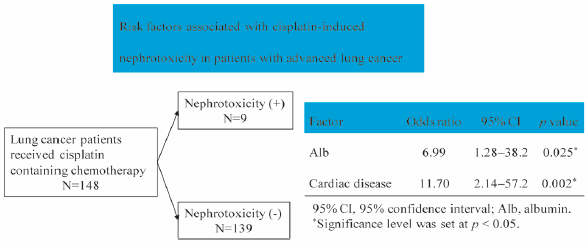 Graphical Abstract Fullsize Image抄録全体を表示PDF形式でダウンロード (399K) HTML形式で全画面表示
Graphical Abstract Fullsize Image抄録全体を表示PDF形式でダウンロード (399K) HTML形式で全画面表示 -
Wataru Ochiai, Akiyo Hirose, Taisuke Kawamura, Kyoko Komachi, Yuka Yam ...2016 年 39 巻 12 号 p. 2015-2021
発行日: 2016/12/01
公開日: 2016/12/01
ジャーナル フリー HTMLThe drug-metabolizing enzyme CYP is mainly involved in the metabolism of various substances in the liver, such as drugs, endogenous substances, and carcinogens. Recent reports have also revealed that CYP1B1 plays a major role in the developmental process. Because the level of CYP expression is markedly high in the liver, we hypothesize that CYP plays a role in the developmental process of the liver. To verify this hypothesis, we analyzed the expression patterns of various CYP molecular species and their functions during the differentiation of embryonic stem cells (ES cells) into hepatocytes and the developmental process in mice. The results demonstrated that CYP2R1 and CYP26A1 are expressed at an earlier stage of the differentiation of ES cells into hepatocytes than hepatoblast-specific markers. Additionally, during the development of the mouse liver, CYP2R1 and CYP26A1 were mostly up-regulated during the stage when hepatoblasts appeared. In addition, when CYP2R1 and CYP26A1 expressions were forced in ES cells and liver of adult mice, they differentiated into hepatoblast marker positive cells. These results suggest that CYP2R1 and CYP26A1 may play a major role in hepatoblast cell differentiation during the development of the liver.
 Graphical Abstract Fullsize Image抄録全体を表示PDF形式でダウンロード (3597K) HTML形式で全画面表示
Graphical Abstract Fullsize Image抄録全体を表示PDF形式でダウンロード (3597K) HTML形式で全画面表示 -
Shota Yokoyama, Hideyuki Tsuji, Sachiko Hiraoka, Masayuki Nishihara2016 年 39 巻 12 号 p. 2022-2027
発行日: 2016/12/01
公開日: 2016/12/01
ジャーナル フリー HTMLMetformin is a biguanaide antidiabetic drug used worldwide, and its effectiveness and benefits have already been established. However, the safety of high doses of metformin in Japanese patients, especially in elderly patients with a decreased renal function, remains unclear. Among the side effects of metformin, lactate acidosis is the most problematic due to a high mortality rate. Therefore, we assessed plasma lactate levels in metformin-treated patients to identify independent risk factors for hyperlactemia. 290 outpatients receiving various doses of metformin at our hospital were enrolled between March and July 2014. Serum electrolytes, Cre (creatinine), BUN (blood urea nitrogen), UA (uric acid), HbA1c (hemoglobin A1c), and lactate levels were investigated. Lactate levels did not significantly differ between the elderly (≥75 years) and non-elderly (<75 years) groups. Patients in the elderly group had a significantly lower daily metformin dose and estimated glomerular filtration rate (eGFR), compared with the non-elderly group (both p<0.005). Between with and without hyperlactemia groups, no significant differences were observed in either Cre or age. On the other hand, patients with hyperlactemia had a significantly higher dose of metformin than those without hyperlactemia (p<0.05). In this study, we found that old age and mildly impaired kidney function were not associated with increased lactate levels, and that a higher dose of metformin may be an independent risk factor for elevated lactate levels in Japanese patients.
 Graphical Abstract Fullsize Image抄録全体を表示PDF形式でダウンロード (469K) HTML形式で全画面表示
Graphical Abstract Fullsize Image抄録全体を表示PDF形式でダウンロード (469K) HTML形式で全画面表示 -
Yun Zhang, Ming Yan, Qing-feng Yu, Pei-fan Yang, Hai-dong Zhang, Yong- ...2016 年 39 巻 12 号 p. 2028-2035
発行日: 2016/12/01
公開日: 2016/12/01
ジャーナル フリー HTMLOsteolysis induced by chronic Gram-negative bacterial infection underlies many bone diseases such as osteomyelitis, septic arthritis, and periodontitis. Drugs that inhibit lipopolysaccharide (LPS)-induced osteolysis are critically needed for the prevention of bone destruction in infective bone diseases. In this study, we assessed the effect of puerarin, a natural isoflavone isolated from Pueraria lobata OHWI root, on LPS-induced osteoclastogenesis and bone loss. Our in vitro study showed that puerarin significantly inhibited LPS-induced osteoclast differentiation from osteoclast precursor RAW264.7 cells. The inhibition occurred through suppressing the production of osteoclast activating factor tumor necrosis factor (TNF)-α, interleukin (IL)-1β and prostaglandin E2 (PGE2), which led to down-regulating mRNA expression of osteoclastogenic genes including tartrate-resistant acid phosphatase (TRAP), cathepsin K and matrix metalloprotein 9 (MMP-9). Furthermore, LPS triggered activation of Akt in osteoclast precursor RAW264.7 cells, which was inhibited by puerarin treatment. In vivo, puerarin attenuated LPS-induced bone loss in a murine calvarial osteolysis model. Collectively, puerarin prevents LPS-induced osteoclast formation, function and bone loss, where the inhibition of Akt activation plays an important role. These findings provide evidences that puerarin might be beneficial as a promising candidate drug for the prevention and treatment of bacteria-induced bone destruction disease, and give new insights for understanding its possible mechanism.
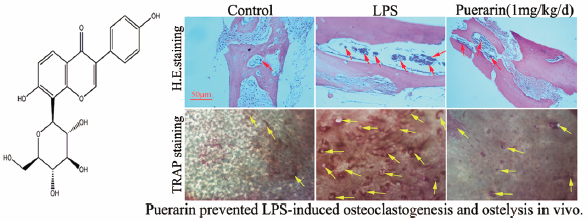 Graphical Abstract Fullsize Image抄録全体を表示PDF形式でダウンロード (2520K) HTML形式で全画面表示
Graphical Abstract Fullsize Image抄録全体を表示PDF形式でダウンロード (2520K) HTML形式で全画面表示 -
Shuhei Hattori, Tetsuro Kamiya, Hirokazu Hara, Masayuki Ninomiya, Mamo ...2016 年 39 巻 12 号 p. 2036-2041
発行日: 2016/12/01
公開日: 2016/12/01
ジャーナル フリー HTML
電子付録Extracellular-superoxide dismutase (EC-SOD), one of the SOD isozymes, is negatively regulated under hypoxic conditions, and decreases in its expression may exacerbate vascular diseases. Moreover, epigenetics, such as DNA methylation and histone modifications, are known to play a critical role in the progression of cancer, type 2 diabetes, and atherosclerosis. We previously investigated the involvement of reactive oxygen species (ROS) and p38 mitogen-activated protein kinase (MAPK) in decreases in EC-SOD expression in hypoxic COS7 cells; however, the role of epigenetics in this process currently remains unknown. In the present study, we demonstrated that the hypoxia mimetic cobalt chloride (CoCl2) decreased histone acetylation levels, and a pretreatment with 4-phenyl butyric acid (PBA), an inhibitor of histone deacetylase, significantly suppressed CoCl2-elicited histone deacetylation and decreases in EC-SOD. We found that CoCl2-elicited decreases in EC-SOD were accompanied by reductions in histone H3 acetylation levels within its promoter region. Furthermore, luteolin, a well-known flavonoid, significantly suppressed the CoCl2-elicited accumulation of ROS, p38-MAPK activation, and histone deacetylation. Collectively, the results of the present study showed for the first time that CoCl2 decreases the expression of EC-SOD through its deacetylation and luteolin may be one of the seed compounds that maintain redox homeostasis, even under hypoxic conditions.
 Graphical Abstract Fullsize Image抄録全体を表示PDF形式でダウンロード (824K) HTML形式で全画面表示
Graphical Abstract Fullsize Image抄録全体を表示PDF形式でダウンロード (824K) HTML形式で全画面表示 -
Hyeon-Son Choi, Suji Im, Je Won Park, Hyung Joo Suh2016 年 39 巻 12 号 p. 2042-2051
発行日: 2016/12/01
公開日: 2016/12/01
ジャーナル フリー HTML
電子付録The anti-osteoarthritic activity of the methanol fraction of deer bone oil extract (DBO-M) was evaluated in interleukin (IL)-1β-inflamed primary rabbit chondrocytes and in rats with monosodium iodoacetate (MIA)-induced osteoarthritis. The active compound in DBO-M was analyzed using a direct infusion liquid chromatography quadrupole (LCQ) ion-trap electrospray ionization (ESI)-mass spectrometer (MS). DBO-M significantly suppressed the IL-1β-induced sulfated-glycosaminoglycan (s-GAG) release from chondrocyte, and lowered mRNA levels of the collagen-degrading enzymes matrix metalloproteinase (MMP)-1 and MMP-3 in a dose-dependent manner. Upon treatment with high doses of DBO-M, the levels of IL-1β, tumor necrosis factor (TNF)-α, and IL-6 decreased by around 40, 70, and 50%, respectively, compared to the control in the serum of rats with MIA-induced osteoarthritis. Bone volume fraction (BV/TV) and trabecular thickness (Tb.Th) increased by over 40% in rats treated with DBO-M compared to the values reported for the MIA-treated control group, while trabecular separation (Tb.Sp) showed a significant decrease (ca. 38%), as confirmed through micro-computed tomography (CT) analysis of MIA-induced destruction of articular bones. Furthermore, direct infusion ESI-MS analysis showed that DBO-M contains gangliosides, which are glycosphingolipids with monosialic acid (GM3), as a major compound. Our results suggest that DBO-M effectively improves MIA-induced osteoarthritis by suppressing inflammatory responses, and that gangliosides could be one of the DBO-derived anti-inflammatory components.
 Graphical Abstract Fullsize Image抄録全体を表示PDF形式でダウンロード (1694K) HTML形式で全画面表示
Graphical Abstract Fullsize Image抄録全体を表示PDF形式でダウンロード (1694K) HTML形式で全画面表示 -
Dan Liu, Jie Wu, Hongbo Xie, Mingyi Liu, Isaiah Takau, Hong Zhang, Yuq ...2016 年 39 巻 12 号 p. 2052-2059
発行日: 2016/12/01
公開日: 2016/12/01
ジャーナル フリー HTMLHesperetin (HET) and naringenin (NGR) are flavanones found in citrus (oranges and grapefruit) and Aurantii Fructus Immaturus. The present study aims to investigate the inhibition potential of HET and NGR derivatives towards one of the most important phase II drug-metabolizing enzymes-uridine diphosphate (UDP)-glucuronosyltransferases (UGTs). We used trifluoperazine as a probe substrate to test UGT1A4 activity, and recombinant UGT-catalyzed 4-methylumbelliferone glucuronidation was used as a probe reaction for other UGT isoforms. Data show that HET and NGR displayed broad-spectrum inhibition against human UGTs. Besides, HET exhibited strong inhibitory effects on UGT1A1, 1A3 and 1A9 (both IC50 and Ki values lower than 10 µM), and the inhibitory effects of NGR against three major UGTs, including UGT1A1, 1A3 and 2B7. In a combination of inhibition parameters (Ki) and in vivo concentration of HET and NGR, the potential in vivo inhibition magnitude was predicted. Based on the reported maximum plasma concentration of HET and NGR in vivo, these findings indicate the potential herb–drug interactions (HDI) between HET or NGR and the drugs mainly undergoing UGT1A3 or UGT2B7 catalyzed metabolic elimination. Considering the variety of citrus that contains HET and NGR, so caution should be applied when taking drugs that utilize UGTs for metabolism and clearance with citrus fruits.
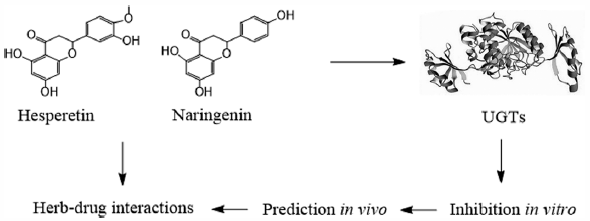 Graphical Abstract Fullsize Image抄録全体を表示PDF形式でダウンロード (1581K) HTML形式で全画面表示
Graphical Abstract Fullsize Image抄録全体を表示PDF形式でダウンロード (1581K) HTML形式で全画面表示 -
Kazuki Ide, Izumi Sato, Takumi Imai, Philip Hawke, Hiroshi Yamada, Yoh ...2016 年 39 巻 12 号 p. 2060-2065
発行日: 2016/12/01
公開日: 2016/12/01
[早期公開] 公開日: 2016/09/17ジャーナル フリー HTML
電子付録This study compares the safety profiles of pegylated interferon (PEG-IFN) α-2a and α-2b administered in combination with ribavirin, based on the variable of time to withdrawal from treatment due to adverse events. We conducted a real-world retrospective cohort study using the Japanese interferon database. Based on eligibility criteria, individuals with chronic hepatitis C virus (HCV) infection were identified in the database covering the period December 2009 to August 2015. The primary outcome measure was defined as difference in time to withdrawal from treatment due to adverse events between patients receiving PEG-IFN α-2a combined with ribavirin and those receiving PEG-IFN α-2b combined with ribavirin. The difference was analyzed using the multivariate Cox proportional hazards regression model. A frailty model was also applied to consider regional (prefectural) variation. After eligibility evaluation, 11058 individuals were included in the analysis. 3774 were treated with PEG-IFN α-2a, and 6764 with PEG-IFN α-2b, with 11.84 and 12.30% respectively withdrawing from treatment due to adverse events. The Cox model showed no significant difference between the two groups (hazard ratio (HR), 95%CI; 0.918, 0.817 to 1.031; p=0.1475). The results were consistent even when regional variation and other confounding variables were adjusted in the frailty model. In conclusion, there may be no difference in time to withdrawal from treatment due to adverse events between PEG-IFN α-2a and PEG-IFN α-2b combined with ribavirin. Applying the method used here to future studies using novel treatment regimens may also provide important information for the treatment of chronic HCV infection in clinical practice.
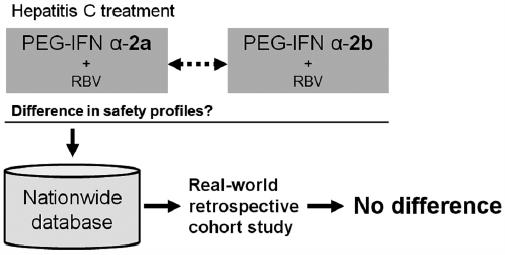 Graphical Abstract Fullsize Image抄録全体を表示PDF形式でダウンロード (466K) HTML形式で全画面表示
Graphical Abstract Fullsize Image抄録全体を表示PDF形式でダウンロード (466K) HTML形式で全画面表示
-
Fang Peng, Rong Xu, Xia Wang, Changqing Xu, Tongning Liu, Jun Chen2016 年 39 巻 12 号 p. 2066-2070
発行日: 2016/12/01
公開日: 2016/12/01
ジャーナル フリー HTML
電子付録Effect of steaming on postharvest stems of Cistanche deserticola Y. C. MA was evaluated periodically during sun drying in both years. Steamed stems exhibited oily black in color, slightly heavier and longer than untreated ones. The levels of five phenylethanoid glycosides and 2,2-diphenyl-1-picrylhydrazyl free radical (DPPH) scavenging activity in steamed stems remained relatively stable during sun drying. Steamed samples showed higher amounts of water-soluble extracts, dilute ethanol-soluble extracts, soluble sugars, and polysaccharides, while a lower level of total ashes than untreated samples. The overall results suggest that steaming is an effective processing for enhancing the appearance quality and the concentration of some bioactive compounds in Cistanches Herba.
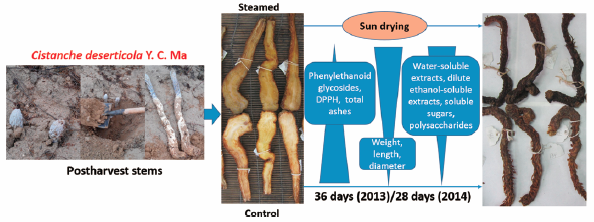 Graphical Abstract Fullsize Image抄録全体を表示PDF形式でダウンロード (662K) HTML形式で全画面表示
Graphical Abstract Fullsize Image抄録全体を表示PDF形式でダウンロード (662K) HTML形式で全画面表示
- |<
- <
- 1
- >
- >|